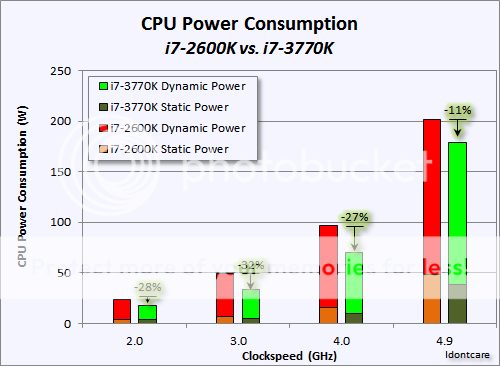- Oct 9, 1999
- 5,143
- 3,742
- 136
In 2006 Intel presented it's new tick-tock plan where they would release a new process one year and a new architecture the next.
So have they kept their word?
If you were competing with Intel would their track record since 2006 make you think they were vulnerable or a very, very tough competitor?
(dates rounded to nearest month)
August 2006 > Conroe - 65nm 4-wide superscaler processor, ability to power down parts of the core when not being used, better out-of-order branch prediction, shared L2 among between cores, better prefetch, memory disambiguation, ability to process 128-bit SSE operands in one cycle, SSE4. Conroe returned the performance crown to Intel.
16 months later
November 2008 > Penryn - 45nm Hafnium+Metal process, mobile C6 deep sleep state for mobile parts, twice as fast Radix 16 divider, larger L2 (3MB/core), split load cache enhancement, higher bus speeds, 128-bit super shuffle engine to improve SSE performance, new SSE 4 instructions for multi-media, better virtualization (ring-deprivileging).
10 months later
November 2008 > Nehalem - Quad core in one die, Power control unit to power down cores, macro-op fusion enhancement, improved loop stream detector, 128 uops in flight, new cache structure L1/L2 per core, shared L3, 2nd level branch predictor, renamed return stack buffer (prevent stack corruption), return of hyperthreading, one die memory controller, 128-bit wide SSE 4.1 and new SSE 4.2.
13 months
January 2010 > Westmere - 32nm process with on package graphics, memory controller moved to GPU (worse memory performance), 1st 6 core in one die parts (Gulftown), gated uncore, 1.35V memory support, AES-NI, 1GB page sizes, better virtualization, HD Graphics.
12 months
January 2011 > Sandy Bridge - System Agent power control for PCIe, DMI, memory controller.., new branch predictor, addition of physical register file, better turbo, ring bus, micro-op cache, multiplier o/c on "K" parts, AVX extensions, Add with Carry throughput doubled, integrated graphics moved to CPU die, faster graphics (12 EUs up from 10 in Westmere).
14 months
May 2013 > Ivy Bridge - 22nm Tri-Gate Transistors, DDR3 power gating, lower system agent voltages, more accurate voltage characterization, power aware interrupt routing, configurable TDP, dynamically partitioned internal structures for better single threaded performance, prefetcher improvement, floating point/integer improvement, MOV operation improvement, digital random number generator, supervisory mode for execution protection, better integrated graphics (16 EU's) PCI express 3.0 and native USB 3.0.
13 months (predicted)
June 2013 > Haswell - Power optimizer for fine grain power control and new S0ix sleep states, decoupled L3 cache (like Nehalem), improved branch predictor, wider execution engine (increase from 6 to 8 ports), 2x cache bandwidth, improved memory controller, AVX 2 instructions, TSX, virtualization improvements, much faster graphics?
So have they kept their word?
If you were competing with Intel would their track record since 2006 make you think they were vulnerable or a very, very tough competitor?
(dates rounded to nearest month)
August 2006 > Conroe - 65nm 4-wide superscaler processor, ability to power down parts of the core when not being used, better out-of-order branch prediction, shared L2 among between cores, better prefetch, memory disambiguation, ability to process 128-bit SSE operands in one cycle, SSE4. Conroe returned the performance crown to Intel.
16 months later
November 2008 > Penryn - 45nm Hafnium+Metal process, mobile C6 deep sleep state for mobile parts, twice as fast Radix 16 divider, larger L2 (3MB/core), split load cache enhancement, higher bus speeds, 128-bit super shuffle engine to improve SSE performance, new SSE 4 instructions for multi-media, better virtualization (ring-deprivileging).
10 months later
November 2008 > Nehalem - Quad core in one die, Power control unit to power down cores, macro-op fusion enhancement, improved loop stream detector, 128 uops in flight, new cache structure L1/L2 per core, shared L3, 2nd level branch predictor, renamed return stack buffer (prevent stack corruption), return of hyperthreading, one die memory controller, 128-bit wide SSE 4.1 and new SSE 4.2.
13 months
January 2010 > Westmere - 32nm process with on package graphics, memory controller moved to GPU (worse memory performance), 1st 6 core in one die parts (Gulftown), gated uncore, 1.35V memory support, AES-NI, 1GB page sizes, better virtualization, HD Graphics.
12 months
January 2011 > Sandy Bridge - System Agent power control for PCIe, DMI, memory controller.., new branch predictor, addition of physical register file, better turbo, ring bus, micro-op cache, multiplier o/c on "K" parts, AVX extensions, Add with Carry throughput doubled, integrated graphics moved to CPU die, faster graphics (12 EUs up from 10 in Westmere).
14 months
May 2013 > Ivy Bridge - 22nm Tri-Gate Transistors, DDR3 power gating, lower system agent voltages, more accurate voltage characterization, power aware interrupt routing, configurable TDP, dynamically partitioned internal structures for better single threaded performance, prefetcher improvement, floating point/integer improvement, MOV operation improvement, digital random number generator, supervisory mode for execution protection, better integrated graphics (16 EU's) PCI express 3.0 and native USB 3.0.
13 months (predicted)
June 2013 > Haswell - Power optimizer for fine grain power control and new S0ix sleep states, decoupled L3 cache (like Nehalem), improved branch predictor, wider execution engine (increase from 6 to 8 ports), 2x cache bandwidth, improved memory controller, AVX 2 instructions, TSX, virtualization improvements, much faster graphics?



